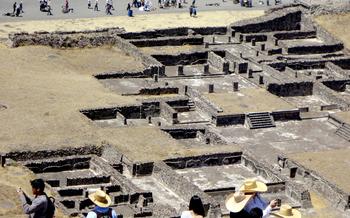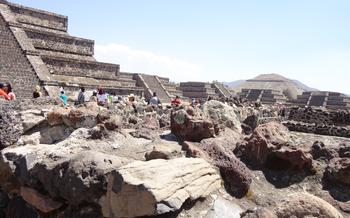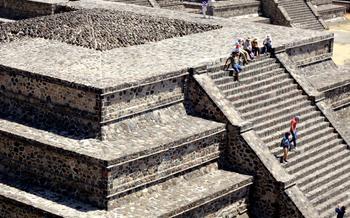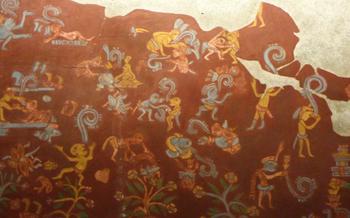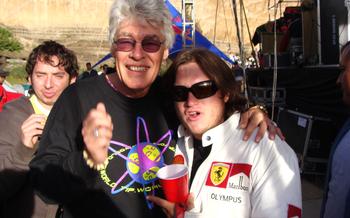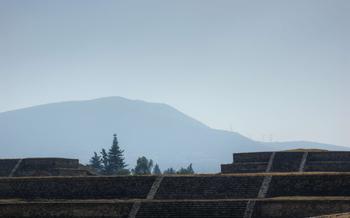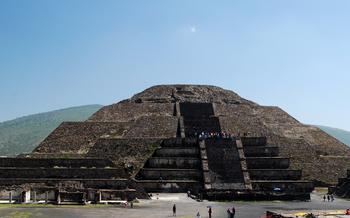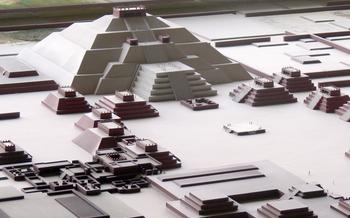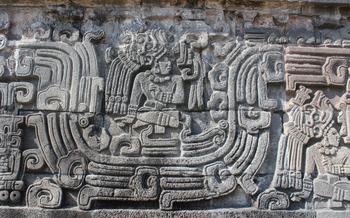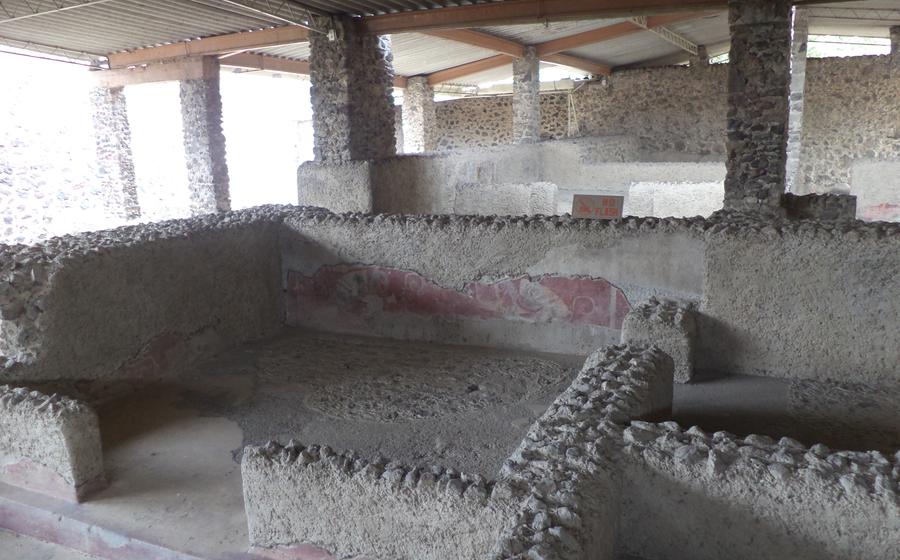
Palacio de Tetitla
- Palacio de Tetitla: A Glimpse into Teotihuacan's Aristocratic Life
- Location and Accessibility
- Hours of Operation and Admission Fees
- Exploring the Palacio de Tetitla: A Journey into Teotihuacan's Aristocratic Life
- The Murals of Tetitla: A Masterpiece of Teotihuacan Art
- A Walk Through History: The Xalla Trail
- Unveiling Tetitla's Secrets: Ongoing Archaeological Research
- Capturing the Essence of Tetitla: Photography Tips
- Exploring Beyond Tetitla: Neighboring Sites and Attractions
- Local Cuisine and Dining Options
- Accommodation Options for Every Traveler
- Respecting Local Customs and Traditions
- Safety Tips for a Hassle-Free Visit
- Insider Tip: Unveiling Hidden Details with a Guide
Palacio de Tetitla: A Glimpse into Teotihuacan's Aristocratic Life
The Palacio de Tetitla, nestled within the ancient city of Teotihuacan, offers a captivating glimpse into the lives of the city's elite. This magnificent palace, with its intricate murals and opulent architecture, once served as a residence for Teotihuacan's most powerful families. Its strategic location, in close proximity to the city's religious and political center, underscores its significance as a seat of power and influence. The palace's unique features, including its elaborate courtyards, grand halls, and painted chambers, provide a tangible connection to the grandeur and sophistication of Teotihuacan's ruling class.
Location and Accessibility
The Palacio de Tetitla is situated within the ancient city of Teotihuacan, approximately 40 kilometers northeast of Mexico City. It is located in the western sector of the city, near the Ciudadela and the Pyramid of the Moon. Visitors can easily reach Teotihuacan by taking a bus or tour from Mexico City's central bus station, Terminal Central de Autobuses del Norte. The trip takes about an hour, and buses depart frequently throughout the day. Once in Teotihuacan, visitors can walk or take a taxi to the Palacio de Tetitla. Self-guided tours are possible, but guided tours are highly recommended for a more in-depth understanding of the site's history and significance.
Hours of Operation and Admission Fees
The Palacio de Tetitla is open to visitors daily from 9:00 AM to 5:00 PM. Admission fees vary depending on age and residency status. For adults, the entrance fee is 80 pesos, while children and students with valid IDs pay 40 pesos. Concessions are available for seniors and people with disabilities at a reduced rate of 20 pesos.
Guided tours are available for a more in-depth experience of the palace and its history. The cost of a guided tour is 150 pesos per person, in addition to the entrance fee. It is recommended to book guided tours in advance, especially during peak tourist season, to secure a spot.
To avoid crowds and enjoy a more tranquil visit, consider arriving early in the morning or later in the afternoon. Weekdays tend to be less crowded compared to weekends and holidays.
Exploring the Palacio de Tetitla: A Journey into Teotihuacan's Aristocratic Life
As you step through the entrance of the Palacio de Tetitla, a sense of awe and wonder envelops you. The palace unfolds before you, its layout mirroring the grandeur of Teotihuacan's urban design. Explore the various courtyards, each serving a distinct purpose. The central courtyard, the largest and most impressive, was likely used for ceremonies and gatherings. Admire the intricate murals adorning the walls, depicting scenes of daily life, religious rituals, and mythological tales.
Discover the numerous rooms that once housed Teotihuacan's elite, each adorned with unique murals and decorative elements. These murals provide glimpses into the lives of the palace's inhabitants, their customs, and their beliefs. Pay close attention to the symbolism and iconography present in the artwork, as they hold clues to the cultural and spiritual significance of the palace.
One of the highlights of the Palacio de Tetitla is the "Procession of the Feathered Serpent" mural. This awe-inspiring masterpiece depicts a procession of Teotihuacan's elite, adorned in elaborate costumes and headdresses, paying homage to the sacred feathered serpent deity, Quetzalcoatl. The mural's vibrant colors and intricate details offer a captivating glimpse into the city's religious beliefs and rituals.
As you wander through the palace, imagine the bustling activity that once filled these spaces. Picture the palace's inhabitants going about their daily lives, hosting lavish banquets, conducting religious ceremonies, and discussing matters of governance. The Palacio de Tetitla stands as a testament to the sophistication and cultural richness of Teotihuacan's aristocratic society, inviting you to unravel its secrets and immerse yourself in the grandeur of ancient Mexico.
The Murals of Tetitla: A Masterpiece of Teotihuacan Art
The Palacio de Tetitla is adorned with exquisite murals that rank among the finest examples of Teotihuacan art. These vibrant and intricate paintings cover the walls of the palace's interior chambers, depicting a rich tapestry of mythological scenes, deities, and everyday life. The murals were created using a variety of techniques, including fresco, tempera, and secco, and display a remarkable level of artistic skill and craftsmanship.
The symbolism and meanings behind the depicted figures and scenes are still being deciphered by scholars, but many of the murals appear to be related to religious and mythological themes. One particularly striking mural depicts the Feathered Serpent, a central deity in Teotihuacan mythology, emerging from a conch shell, symbolizing creation and rebirth. Other murals depict scenes of human sacrifice, processions, and rituals, offering a glimpse into the religious practices of Teotihuacan's elite.
The murals of Tetitla are not only aesthetically stunning but also provide valuable insights into the beliefs, rituals, and daily life of Teotihuacan's ruling class. By studying these remarkable works of art, we can gain a deeper understanding of one of the most sophisticated and influential civilizations of ancient Mesoamerica.
In comparison to other notable murals in Teotihuacan, such as those found in the Temple of Quetzalcoatl or the Pyramid of the Sun, the murals of Tetitla stand out for their exceptional detail, vibrant colors, and narrative complexity. These murals offer a unique perspective on Teotihuacan art and culture, making the Palacio de Tetitla a must-visit destination for anyone interested in the history and legacy of this ancient city.
A Walk Through History: The Xalla Trail
In addition to exploring the Palacio de Tetitla itself, visitors can embark on a captivating journey through history by following the Xalla Trail. This scenic path winds its way from the modern-day entrance of Teotihuacan to the palace, offering a unique perspective on the ancient city's layout and grandeur.
As you tread along the Xalla Trail, you'll be transported back in time, imagining the footsteps of ancient Teotihuacans who once traversed this path for religious ceremonies, trade, or daily life. Along the way, you'll encounter fascinating historical landmarks that provide glimpses into the city's past.
One of the highlights of the Xalla Trail is the Cave of the Rats, a natural formation that was once used for ceremonial purposes. The cave's walls are adorned with intricate petroglyphs, offering a glimpse into the spiritual beliefs and practices of the Teotihuacan people.
Further along the trail, you'll come across the remains of ancient structures, including residential compounds and workshops. These ruins provide valuable insights into the daily lives of Teotihuacan's inhabitants, showcasing their architectural skills and craftsmanship.
As you approach the Palacio de Tetitla, the trail culminates in a breathtaking view of the palace complex, its towering walls and vibrant murals standing as a testament to the artistry and power of the Teotihuacan civilization.
To fully appreciate the Xalla Trail, consider setting aside ample time to explore its many wonders. Wear comfortable shoes, bring water and sunscreen, and be prepared for uneven terrain. The trail is relatively easy to navigate, but it's recommended to consult a map or guide to ensure you don't miss any hidden gems along the way.
Unveiling Tetitla's Secrets: Ongoing Archaeological Research
The Palacio de Tetitla is a treasure trove of archaeological wonders, and ongoing research continues to shed light on its rich history and significance. Excavations have revealed intricate details about the palace's construction, uncovering hidden chambers, passageways, and artifacts that provide clues to the lives of its inhabitants. Archaeologists have also discovered evidence of workshops and craft areas, suggesting that the palace was not only a residence but also a center of artistic production.
The study of Tetitla's murals has been particularly fruitful, providing insights into the religious beliefs and iconography of Teotihuacan. Researchers have identified recurring motifs and symbols that offer clues to the city's mythology and cosmology. Ongoing analysis of the murals' pigments and techniques has also contributed to a better understanding of Teotihuacan's artistic traditions and influences.
Collaboration between archaeologists and historians is essential in piecing together the story of Tetitla. By combining archaeological evidence with historical texts and ethnohistorical accounts, researchers can gain a more comprehensive understanding of the palace's role in Teotihuacan's social and political landscape. This collaborative approach has led to new theories about the palace's abandonment and its significance as a symbol of power and prestige.
The ongoing archaeological research at the Palacio de Tetitla is vital for preserving and protecting Teotihuacan's cultural heritage. By uncovering the secrets of this ancient city, archaeologists are helping to ensure that future generations can appreciate and learn from its remarkable achievements.
Capturing the Essence of Tetitla: Photography Tips
The Palacio de Tetitla, with its intricate murals and architectural details, presents a captivating opportunity for photography enthusiasts. To capture the essence of this ancient palace, consider the following tips:
-
Camera Settings: Opt for a wide-angle lens to capture the palace's grandeur and a telephoto lens for detailed shots of murals and architectural elements. Use a tripod to ensure stability and avoid blurry images.
-
Lighting: The best time to photograph Tetitla is during the "golden hours" around sunrise and sunset when the warm light enhances the colors and textures of the palace.
-
Composition: Experiment with different angles and perspectives to create dynamic compositions. Look for leading lines, such as pathways or columns, to draw the viewer's eye into the image.
-
Murals: To capture the vibrant colors and intricate details of the murals, adjust your camera's white balance and exposure settings accordingly. Use a flash to illuminate the murals evenly, avoiding harsh shadows.
-
Respectful Photography: Remember to be respectful of other visitors and the palace's sacred nature. Avoid using flash photography near other people or disturbing the peace of the site.
Exploring Beyond Tetitla: Neighboring Sites and Attractions
A visit to the Palacio de Tetitla opens up a world of exploration beyond its walls. The surrounding area is dotted with ancient ruins, captivating museums, and natural wonders, each offering a unique glimpse into Teotihuacan's rich history and diverse cultural heritage.
A short walk from the Palacio de Tetitla lies the iconic Pyramid of the Sun, the largest pyramid in the Americas. Towering over the landscape, this colossal structure is a testament to the architectural prowess of the Teotihuacan people. Climb to the top for breathtaking views of the entire city and the surrounding valley.
Just a stone's throw away is the Pyramid of the Moon, another majestic pyramid with its own unique charm. Explore its tunnels and chambers, and immerse yourself in the mysteries that surround this enigmatic structure.
For a deeper understanding of Teotihuacan's culture and way of life, visit the Teotihuacan Museum. This world-class museum houses an extensive collection of artifacts, sculptures, and murals that shed light on the city's history, religion, and daily life.
If you're looking for a more active adventure, embark on a hike through the Sierra de Guadalupe. This rugged mountain range offers stunning views of the valley and the pyramids, as well as opportunities for rock climbing, mountain biking, and horseback riding.
For a serene escape from the hustle and bustle of the archaeological zone, visit the Santuario de la Virgen de Guadalupe. This beautiful shrine, located just outside of Teotihuacan, is a popular pilgrimage site and offers a tranquil retreat amidst nature.
Whether you're interested in history, culture, nature, or adventure, there's something for everyone in the vicinity of the Palacio de Tetitla. Take the time to explore these neighboring sites and attractions to gain a comprehensive understanding of Teotihuacan's captivating legacy.
Local Cuisine and Dining Options
Teotihuacan's rich history and culture are not only reflected in its ancient ruins but also in its vibrant culinary scene. The region offers a diverse range of dining options, from traditional Mexican cuisine to international fare, catering to every taste and budget.
For an authentic Mexican experience, try the local specialty, barbacoa, a slow-cooked lamb or goat dish that is a testament to the region's culinary heritage. Another must-try is pulque, a traditional fermented beverage made from the sap of the maguey plant, which has been enjoyed in Teotihuacan for centuries.
If you're looking for a unique dining experience, head to one of the many restaurants situated on the rooftops of Teotihuacan's hotels and guesthouses. These restaurants offer breathtaking views of the ancient city while you savor delicious Mexican dishes and international cuisine.
Whether you prefer a casual meal at a local eatery or a fine-dining experience with a view, Teotihuacan offers a culinary journey that will delight your taste buds and leave you wanting more.
Accommodation Options for Every Traveler
Teotihuacan offers a range of accommodation options to suit every traveler's needs and budget. From budget-friendly hostels and guesthouses to luxurious resorts, there's something for everyone. For those seeking a convenient and immersive experience, hotels and guesthouses near the Palacio de Tetitla are recommended. These establishments provide easy access to the palace and other attractions, allowing visitors to make the most of their time in Teotihuacan.
When booking accommodation, it's advisable to plan ahead, especially during peak tourist seasons. Online booking platforms and travel agents can assist in finding the best deals and availability. Consider factors such as proximity to attractions, amenities, and budget when making a choice.
For a truly unique experience, consider staying in a traditional Mexican hacienda or quinta. These historic properties offer a glimpse into Mexico's rich cultural heritage and provide a tranquil retreat after a day of exploring Teotihuacan.
Respecting Local Customs and Traditions
When visiting the Palacio de Tetitla and other sacred sites in Mexico, it's essential to be mindful of local customs and traditions to ensure a respectful and meaningful experience. Here are some guidelines to keep in mind:
-
Dress Code: While there is no strict dress code, modest attire is generally expected when visiting religious or historical sites. Avoid wearing revealing or overly casual clothing.
-
Behavior: Be respectful and maintain a quiet demeanor. Avoid loud talking, boisterous behavior, or engaging in activities that may disturb the tranquility of the site.
-
Photography: While photography is generally allowed, be mindful of the lighting conditions and avoid using flash photography, which can damage the ancient murals.
-
Local Customs: Familiarize yourself with local customs and traditions related to visiting sacred sites. For example, it's customary to show respect to the indigenous people and their cultural heritage.
-
Respect the Environment: Help preserve the natural and cultural heritage of Teotihuacan by refraining from littering, damaging plants or structures, or engaging in any activities that may harm the environment.
-
Support the Community: Support the local community by purchasing souvenirs from local artisans, dining at local restaurants, and booking tours with local guides. This helps sustain the local economy and ensures that the benefits of tourism are shared by the community.
By following these guidelines, you can contribute to the preservation of Teotihuacan's cultural heritage while demonstrating respect for the local community and their traditions, making your visit a truly enriching and meaningful experience.
Safety Tips for a Hassle-Free Visit
Visiting Teotihuacan and the Palacio de Tetitla should be a safe and enjoyable experience for all. Here are some essential safety tips to keep in mind:
- Be aware of your surroundings and belongings, especially in crowded areas.
- Avoid carrying large amounts of cash or valuables.
- Keep your passport and other important documents securely stored.
- Stay hydrated by bringing a water bottle or purchasing one from local vendors.
- Wear comfortable shoes as you'll be doing a lot of walking on uneven surfaces.
- Be mindful of the sun's intensity and apply sunscreen regularly.
- Respect the local culture and traditions by dressing appropriately and behaving respectfully.
- If you encounter any safety concerns or suspicious activity, don't hesitate to approach a security guard or local authority for assistance.
By following these simple safety tips, you can ensure that your visit to the Palacio de Tetitla and Teotihuacan is both memorable and safe.
Insider Tip: Unveiling Hidden Details with a Guide
Exploring the Palacio de Tetitla with a knowledgeable guide is an enriching experience that unlocks the hidden depths of this ancient palace. Guides provide insightful commentary on the palace's history, architecture, and symbolism, bringing the site's significance to life. They can point out intricate details, explain the symbolism behind the murals, and share stories about the people who once inhabited these spaces.
When choosing a guide, look for someone certified by the Mexican government or a reputable tour operator. Read reviews and ask for recommendations from other travelers to ensure you find a knowledgeable and experienced guide. Negotiate the guide's fee in advance and agree on the duration and scope of the tour to avoid any misunderstandings.
By exploring the Palacio de Tetitla with a guide, you'll gain a deeper understanding of this remarkable site and its place in Teotihuacan's history. It's an investment that will enhance your experience and leave you with a lasting appreciation for this ancient city's grandeur.
